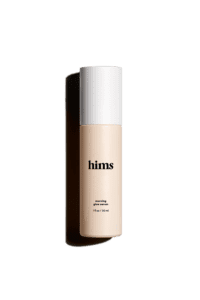A few years ago, men’s hair care products were mostly limited to 2-liter containers of five-in-one, multi-purpose formulas that were meant to serve as shampoo, conditioner, body wash, face wash and deodorizer. Bottles were relegated to a forgotten corner of store shelves. Packaging was red or black, and messaging was hyper-traditional and masculine.
For Hilary Coles’ fiancé, her coworker Andrew Dudum and all of their friends, none of it gelled with their self-image or lifestyle. Coles and Dudum realized there was an opportunity there, and market research has continually confirmed their suspicions that existing men’s products weren’t catering to everyone. In fact, Coles points to a survey from research firm Kantar Group in which 9% of men in Generation Z recently described themselves as “very” or “somewhat feminine” compared with an average 2% of men across the previous four generations.
“That’s an unbelievable seismic shift,” says Coles, who co-founded men’s beauty brand Hims with Dudum after connecting over wellness topics while working at another consumer startup. “We wanted to establish a spectrum of options. There are men who are ready for a Vitamin C serum and reading up on it to try to optimize their skin, and then there are men who don’t really know where to start, but they aren’t happy with the way their hairline looks.”
Launched as a digitally native brand in November 2017, Hims gave guys a modern, nuanced alternative to drug store products typically geared toward men of the lumberjack variety and bad, embarrassing Rogaine commercials. Coles and Dudum set out to debunk the myth that men aren’t interested in self-care regimens and sought to normalize issues like hair loss and erectile dysfunction, or ED, that often are uncomfortable to discuss. ForHims.com publicizes statistics aimed at destigmatizing touchy topics: “You’re not alone. Hair loss affects 50 million men in the U.S.” and “40% of men by age 40 struggle with ED.”
The brand’s strategies allowed Hims, ranked No. 450 in the 2020 Digital Commerce 360 Top 1000, to more than triple its sales in 2019 versus the prior year and snag placement in Target Corp. stores. This week, the company announced it will merge with a special purpose acquisition company (SPAC)—an accelerated alternative to an initial public offering—sponsored by Oaktree Acquisition Corp. The combined company, valued at $1.6 billion, will go public once the transaction is completed.
Coles, who now serves as vice president of merchandising, says the brand’s success stems from its ability to create a culture that grants permission for men to consider their personal wellness needs beyond just regular trips to the gym. Caring for their bodies also includes addressing stubborn acne or adding preventative anti-aging measures.

Hilary Coles, co-founder and vice president of merchandising at Hims
Although Hims also sells over-the-counter items, the “vast majority” of its consumers buy products that require a prescription, Coles says, and a doctor’s green light lends the brand credibility. As a telehealth company, Hims has a network of licensed medical providers in each state and facilitates a virtual evaluation—either in real time or asynchronously—for men shopping for prescription-strength shampoos, creams and pills. Hims takes the friction out of the purchase process by removing the need for a doctor’s office visit and the associated annoyances of waitlists, copays and other deterrents, and offering remote appointments that help guys understand the safest and most effective options for them, Coles says. The company has facilitated more than two million remote consultations to date.
Market research suggests men also tend to be particularly brand loyal and don’t explore as much as women once they find something that works for them, Coles adds.
Within skin care, women try new items every one to three months while men check out different products every three to six months, according to focus groups and consumer surveys, a company spokesperson says. Overall, men are less adventurous within the beauty, grooming and wellness space while women enjoy shopping across a lot of different brands.
“Even if women have a few tried-and-true products that they are loyal to, they will still continue to experiment,” the spokesperson says. “Men tend to like a one-stop shop where they can get a variety of products from one brand due to convenience.”
That paired with the replenishable nature of the products means a recurring revenue stream for Hims. 90% of the brand’s consumers also set up recurring deliveries, and as of June, the company boasted roughly 260,000 subscriptions.
Redesigning men’s products and marketing with humor
Another key move was redesigning the look and feel of men’s products. When Coles’ fiancé ordered items online from other retailers, the delivery was typically one “sad” box rattling around in a bigger box.
“When I order a [women’s self-care] product, it looks beautiful. Everything is placed intentionally, I have samples, I practically have rose petals in there,” Coles says. “It feels purposeful and considered. That’s one of the pieces we thought was missing in the men’s space.”
To combat the lackluster unboxing experience for many men’s products in this category, Hims didn’t skimp on anything. The brand uses high-end New Zealand craft paper for the boxes, items are packed so they lie nicely and don’t roll around when boxes are opened, and the retailer’s third-party logistics company sprays every order with perfume before it ships. The reds and blacks of stereotypical men’s packaging were replaced with shades of neutral tans, and even the products themselves were formulated to give a softer finish in the shower.
“We made these products that historically have been so hard to talk about something that you didn’t need or want to hide in the back of your cupboard but rather were proud to showcase. We strongly believed that there was that flywheel there, and it paid off,” Coles says.
Within weeks of launching, the startup’s Instagram account was flooded with men sharing unboxing videos of them opening Hims’ hair kit, talking about the results, and sending before and after photos. This sparked a viral, organic marketing campaign that relied on word of mouth, Coles says.
Hims’ tongue-in-cheek voice also has served the company well from a marketing perspective, she adds. The brand found humorous messaging allows Hims to break the ice on subjects men are self-conscious about, making them more willing to talk, shop and even share those before and after photos or other user-generated content.
Perhaps the company’s most memorable campaign featured phallic cacti ads plastered over New York City subways and other areas—a nod to erectile dysfunction. Hims also orchestrated a “urinal domination,” or a takeover of toilets at Oracle Park (formerly AT&T Park) in San Francisco, triggering social media posts from baseball fans. Additionally, the brand hired rapper Snoop Dogg to narrate an animated commercial naming Hims as a way out of erectile dysfunction. There is even a fair share of suggestive eggplant emojis sprinkled throughout messaging on ForHims.com.
“We’re willing to go there to break through and let people know we don’t have to take it so seriously,” Coles says. “No one in the history of ballparks ever wanted to advertise in a urinal, but we looked at it as a creative marketing channel that let us have a captive audience for 90 seconds. And images like the cacti are these instantly recognizable symbols for the health topics we’re addressing.”
Strategies for growth
The startup has built a cult following, and it’s showing in the financials. Hims grew web sales by 222.6% in 2019, reaching a Digital Commerce 360-estimated $100 million in annual revenue in just over two years in business. The brand was the second fastest-growing online retailer among…
To get immediate access to the rest of this article—which includes an analysis of the performance of online men’s wellness retailers, Hims’ expansion into Target stores and how the brand’s telehealth infrastructure has left it well-positioned during the pandemic—sign up for a free strategy membership using the “join for free” button below. If you’re already a member, please sign in.